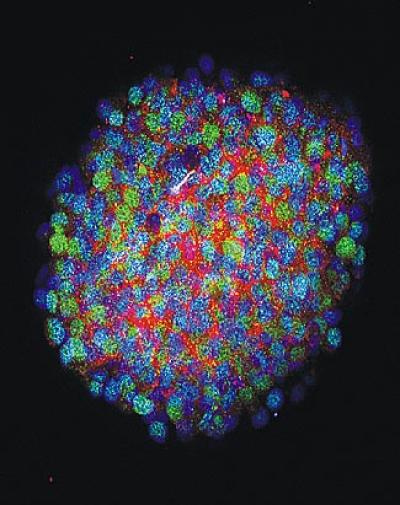Finding the Achilles' Heel of ovarian tumor growth

This image depicts an ovarian tumor spheroid. FAK is stained red, osteopontin green and DNA blue. Credit: UC San Diego School of Medicine
The findings come in a pair of studies published online this week in the journals Gynecologic Oncology and Molecular Cancer Therapeutics.
Ovarian cancer is a leading cause of female cancer death in the United States. On average, more than 21,000 women are diagnosed with ovarian cancer each year and 14,270 die. Many women achieve remission, but cancer recurrence rates exceed 75 percent, prompting the need for new treatments.
“Ovarian cancer spreads within a women's peritoneal space through a unique mechanism that involves the survival of small clusters of tumor cells termed spheroids,” said Schlaepfer. “Our studies show that FAK signaling functions at the center of a tumor cell survival signaling network.”
In the first study, published in Gynecologic Oncology, first author Nina Shah, MD, a gynecological oncology fellow in the Department of Reproductive Medicine, found that ovarian tumor cells with low levels of a tumor suppressor protein, called merlin, displayed heightened sensitivity to FAK inhibitor growth cessation.
“With FAK inhibitor clinical trials already testing a similar linkage in mesothelioma (a rare cancer that affects the protective lining of many internal organs), our results support the hypothesis that protein biomarkers such as merlin may identify those patients who may best respond to FAK inhibitor therapy,” said Schlaepfer.
In the second study in Molecular Cancer Therapeutics, first author Isabelle Tancioni PhD, an assistant project scientist at UC San Diego Moores Cancer Center discovered that a network of signals generated by osteopontin – a beta-5 integrin receptor used in cell-to-cell signaling – and FAK control ovarian cancer spheroid growth.
High levels of beta-5 integrin and FAK expression are associated with a poor prognosis for some ovarian cancer patients. “Thus, high levels of beta-5 integrin may serve as a novel biomarker for ovarian carcinoma cells that possess active FAK signaling,” said Schlaepfer.
Schlaepfer noted that tumor recurrence and metastasis are responsible for the majority of ovarian cancer-related deaths and said the new findings support ongoing clinical trials of FAK inhibitors as new agents in the fight to prevent ovarian cancer progression.
Co-authors include Sean Uryu, Florian J. Sulzmaier, Christine Lawson, Christine Jean, Xiao Lei Chen, Kristy K. Ward and Nichol L.G. Miller, UCSD Moores Cancer Center; and Denise C. Connolly, Fox Chase Cancer Center, Philadelphia, PA.
Funding for this research came, in part, from the National Institutes of Health (grant CA102310) and the non-profit Nine Girls Ask?
Media Contact
All latest news from the category: Life Sciences and Chemistry
Articles and reports from the Life Sciences and chemistry area deal with applied and basic research into modern biology, chemistry and human medicine.
Valuable information can be found on a range of life sciences fields including bacteriology, biochemistry, bionics, bioinformatics, biophysics, biotechnology, genetics, geobotany, human biology, marine biology, microbiology, molecular biology, cellular biology, zoology, bioinorganic chemistry, microchemistry and environmental chemistry.
Newest articles

Peptides on Interstellar Ice
A research team led by Dr Serge Krasnokutski from the Astrophysics Laboratory at the Max Planck Institute for Astronomy at the University of Jena had already demonstrated that simple peptides…

A new look at the consequences of light pollution
GAME 2024 begins its experiments in eight countries. Can artificial light at night harm marine algae and impair their important functions for coastal ecosystems? This year’s project of the training…

Silicon Carbide Innovation Alliance to drive industrial-scale semiconductor work
Known for its ability to withstand extreme environments and high voltages, silicon carbide (SiC) is a semiconducting material made up of silicon and carbon atoms arranged into crystals that is…





















